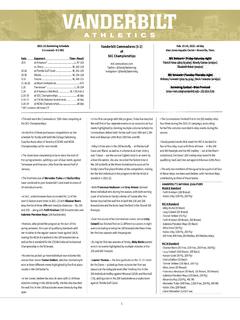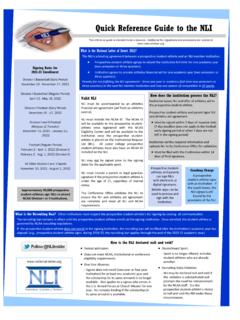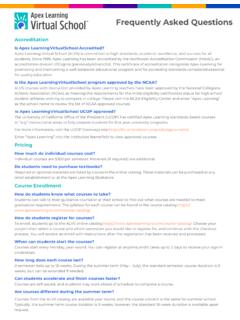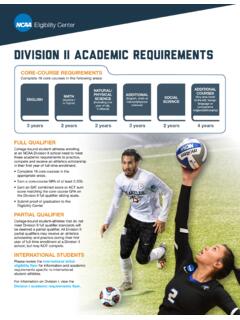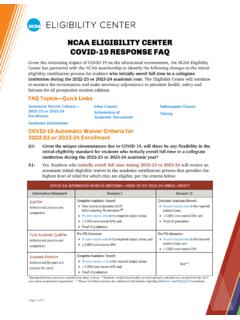Transcription of Guide to Using - Program @RISK
1 Guide to Using @ risk risk Analysis and Simulation Add-In for Microsoft Excel Version February, 2004 Palisade Corporation 31 Decker Road Newfield, NY USA 14867 (607) 277-8000 (607) 277-8001 (fax) (website) (e-mail) Copyright Notice Copyright 2004, Palisade Corporation. Trademark Acknowledgments Microsoft, Excel and Windows are registered trademarks of Microsoft, Inc. IBM is a registered trademark of International Business Machines, Inc. Palisade, TopRank, BestFit and RISK view are registered trademarks of Palisade Corporation.
2 RISK is a trademark of Parker Brothers, Division of Tonka Corporation and is used under license. Welcome i Welcome @RISK for Microsoft Excel Welcome to @RISK, the revolutionary software system for the analysis of business and technical situations impacted by risk! The techniques of Risk Analysis have long been recognized as powerful tools to help decision-makers successfully manage situations subject to uncertainty. Their use has been limited because they have been expensive, cumbersome to use, and have substantial computational requirements.
3 However, the growing use of computers in business and science has offered the promise that these techniques can be commonly available to all decision-makers. That promise has been finally realized with @RISK (pronounced "at risk") a system which brings these techniques to the industry standard spreadsheet package, Microsoft Excel. With @RISK and Excel any risky situation can be modeled, from business to science and engineering. You are the best judge of what your analysis needs require, and @RISK, combined with the modeling capabilities of Excel, allows you to design a model which best satisfies those needs.
4 Anytime you face a decision or analysis under uncertainty, you can use @RISK to improve your picture of what the future could hold. Why You Need Risk Analysis and @RISK Traditionally, analyses combine single "point" estimates of a model's variables to predict a single result. This is the standard Excel model a spreadsheet with a single estimate of results. Estimates of model variables must be used because the values which actually will occur are not known with certainty. In reality, however, many things just don't turn out the way that you have planned.
5 Maybe you were too conservative with some estimates and too optimistic with others. The combined errors in each estimate often lead to a real-life result that is significantly different from the estimated result. The decision you made based on your "expected" result might be the wrong decision, and a decision you never would have made if you had a more complete picture of all possible outcomes. Business decisions, technical decisions, scientific decisions .. all use estimates and assumptions. With @RISK, you can explicitly include the uncertainty present in your estimates to generate results that show all possible outcomes.
6 Ii Welcome @RISK uses a technique called "simulation" to combine all the uncertainties you identify in your modeling situation. You no longer are forced to reduce what you know about a variable to a single number. Instead, you include all you know about the variable, including its full range of possible values and some measure of likelihood of occurrence for each possible value. @RISK uses all this information, along with your Excel model, to analyze every possible outcome. It's just as if you ran hundreds or thousands of "what-if" scenarios all at once!
7 In effect, @RISK lets you see the full range of what could happen in your situation. It's as if you could "live" through your situation over and over again, each time under a different set of conditions, with a different set of results occurring. All this added information sounds like it might complicate your decisions, but in fact, one of simulation's greatest strengths is its power of communication. @RISK gives you results that graphically illustrate the risks you face. This graphical presentation is easily understood by you, and easily explained to others.
8 So when should you use @RISK? Anytime you make an analysis in Excel that could be affected by uncertainty, you can and should use The applications in business, science and engineering are practically unlimited and you can use your existing base of Excel models. An @RISK analysis can stand alone, or be used to supply results to other analyses. Consider the decisions and analyses you make every day! If you've ever been concerned with the impact of risk in these situations, you've just found a good use for @RISK! Modeling Features As an "add-in" to Microsoft Excel, @RISK "links" directly to Excel to add Risk Analysis capabilities.
9 The @RISK system provides all the necessary tools for setting up, executing and viewing the results of Risk Analyses. And @RISK works in a style you are familiar with Excel style menus and functions. @RISK allows you to define uncertain cell values in Excel as probability distributions Using functions. @RISK adds a set of new functions to the Excel function set, each of which allows you to specify a different distribution type for cell values. Distribution functions can be added to any number of cells and formulas throughout your worksheets and can include arguments which are cell references and expressions allowing extremely sophisticated specification of uncertainty.
10 To help you assign distributions to uncertain values, @RISK includes a graphical pop-up window where distributions can be previewed and added to formulas. @RISK Functions Welcome iiiThe probability distributions provided by @RISK allow the specification of nearly any type of uncertainty in cell values in your spreadsheet. A cell containing the distribution function NORMAL(10,10), for example, would return samples during a simulation drawn from a normal distribution (mean = 10, standard deviation = 10). Distribution functions are only invoked during a simulation in normal Excel operations, they show a single cell value just the same as Excel before Available distribution types include.
